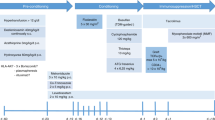Abstract
SCT still remains the only cure currently available for patients with thalassemia. Results of transplants in this disease have steadily improved over the last two decades due to improvements in preventive strategies, effective control of transplant-related complications and development of new preparative regimens. Currently, high-resolution HLA typing has enabled physicians to perform transplants from unrelated volunteer donors for thalassemia with results comparable with those obtained employing an HLA-identical sibling. The probabilities for obtaining thalassemia-free survival after transplant in thalassemia from an HLA-identical donor, family member or MUD are between 85 and 87%. Therefore, when an HLA-identical donor is present, the transplant of allogeneic stem cell should be performed as allogeneic gene therapy. In the light of advances in transplantation for thalassemia, patients with an HLA-identical donor should be offered SCT.
This is a preview of subscription content, access via your institution
Access options
Subscribe to this journal
Receive 12 print issues and online access
$259.00 per year
only $21.58 per issue
Buy this article
- Purchase on Springer Link
- Instant access to full article PDF
Prices may be subject to local taxes which are calculated during checkout
Similar content being viewed by others
Author information
Authors and Affiliations
Corresponding author
Rights and permissions
About this article
Cite this article
Gaziev, J., Sodani, P. & Lucarelli, G. Hematopoietic stem cell transplantation in thalassemia. Bone Marrow Transplant 42 (Suppl 1), S41 (2008). https://doi.org/10.1038/bmt.2008.112
Published:
Issue Date:
DOI: https://doi.org/10.1038/bmt.2008.112
Keywords
This article is cited by
-
Editing the Genome Ex Vivo Stem Cell Therapy
Current Stem Cell Reports (2018)
-
Outcome of hematopoietic cell transplantation in children with sickle cell disease, a single center's experience
Bone Marrow Transplantation (2010)



